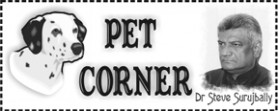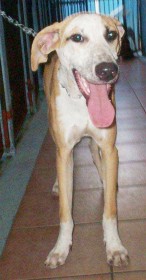Anal gland (sac) disease
Dogs and cats have two small glands/sacs on either side of the anal opening. Scientists seem to be in agreement that the function of the secretion of these glands is to mark the animal’s territory.
 Some people argue also that these ‘scent sacs’ are used by animals to identify each other. That’s why dogs sniff at each other’s rear end. In some animals (the skunk is the best example), the secretion from these glands acts as a form of protection.
Some people argue also that these ‘scent sacs’ are used by animals to identify each other. That’s why dogs sniff at each other’s rear end. In some animals (the skunk is the best example), the secretion from these glands acts as a form of protection.
Whenever the dog/cat defecates, the glands are squeezed and the secretion is released onto the stool. Normally, this secretion is liquid and brownish or even yellow or creamy. It smells terrible.
Causes of anal gland (sac) disease
This ailment represents the commonest disease entity of the anal region in the dog. Dogs of the smaller breeds seem to be more predisposed to this aliment than other larger breeds. That’s mostly why you see small dogs scooting around on their behinds so often.
This disease is also found in the cat – most commonly in the form of an impaction. The anal sacs can become infected and inflamed (after all, look where they are located). Abscesses and even tumours can develop in these sacs. The secretion becomes thick and impacted and cannot exit through the canals.

I have experienced secretions that have become gritty and then very hard. Later fistulas can develop. A fistula is an acquired passage which links a deep seated abscess with the outside surface.
Symptoms
The animals show pain when they try to defecate. Consequently they don’t give off stool easily. This retention of stool creates an impaction/constipation. Sometimes you can see the animal scooting around on its rear end. It licks and bites at the anal area. There is discomfort when sitting. The area around the anus becomes discoloured. The animal strains to defecate.
Treatment
You may try to squeeze the inflamed secretion out of the sac. For the left side sac one would place the gloved index finger of the
right hand into the anus and squeeze the sac between the index finger and the thumb. The same manipulation is done with the left hand for the right side sac. This is nasty business. You are well advised to let your veterinarian carry out this exercise. In fact, he/she might wish to infuse certain chemicals into the sac content to firstly soften up the hard mass in the anal sac. After the sac is cleaned out, your vet may wish to rinse it out with an antiseptic solution before infusing antibiotics into the sac.
Since this is such a painful ailment which can lead to severe constipation, I tend to use a generous dosage of systemic antibiotics and anti-inflammatory agents. Stool softeners may be used and enemas given to ease the pain of defecation. In fact, one might wish to stop feeding completely for a day, followed then by a very liquid diet for the next two or three days.
If the secretion has become as hard as cement or if the inflammatory process recurs often, then the glands should be extirpated totally (surgery).
Enough of this odious subject.
Please implement disease preventative measures (vaccinations, routine dewormings, monthly anti-heartworm medication, etc) and adopt-a-pet from the GSPCA’s Animal Clinic and Shelter at Robb Street and Orange Walk, if you have the wherewithal to care well for the animals. Do not stray your unwanted pets, take them to the GSPCA’s Clinic and Shelter instead. If you do not wish your pet to have puppies or kittens, you may exploit the GSPCA’s free spay and neutering programme. If you see anyone being cruel to an animal, or if you need any technical information, please get in touch with the Clinic and Shelter by calling 226-4237.








